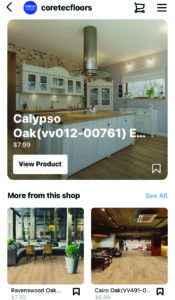 By Megan Salzano-Birch—Social media has grown by leaps and bounds since the 2004 founding of Facebook (a.k.a: Meta)—the “godfather” of modern social media. What began as a desktop communications experience has evolved into a multi-platform, content-sharing and e-commerce phenomenon.
By Megan Salzano-Birch—Social media has grown by leaps and bounds since the 2004 founding of Facebook (a.k.a: Meta)—the “godfather” of modern social media. What began as a desktop communications experience has evolved into a multi-platform, content-sharing and e-commerce phenomenon.
Indeed, one major advancement in digital and social media technologies has been the advent of “social shopping,” or the ability to purchase products directly from a social media application. From IG’s new “Shop” and “Checkout” features to “Facebook Shops,” social media has become a place for consumers to browse and then buy—amazingly, without ever leaving the app. These new developments have changed the game for not only consumers, but for business owners looking to attract consumers and convert them into real buyers and even repeat customers.
What could be described as kismet, the launch of these new shopping features coincided closely with the onset of the COVID-19 pandemic. The result has been unprecedented adoption. “As shelter-in-place measures pushed people across the globe to switch from shopping in-store to online, 2020 has shouldered a decade’s worth of behavior change,” explained Nicola Mendelsohn, vice president, EMEA at Facebook. “This mass digital education of the public has been a cross-generational phenomenon that’s very quickly had a cross-category impact: digitalizing entire consumer journeys, from interest to purchase to customer experience.”
In short, the pandemic caused new shopping behaviors to emerge across generations that point to ongoing utilization of social shopping. In fact, two-thirds (66%) of global shoppers say their mobile device has become their most important shopping tool, according to Ali Hersh Pace, North American luxury and retail lead, Facebook. “Social is now becoming the new flagship store, serving as the main source for product and brand discovery,” she explained. “This embrace of digital and omnichannel shopping has fundamentally changed retail: People have come to expect those same moments of connection and excitement online that they previously could only experience by walking through the doors of a brick-and-mortar store.”
For flooring, that means everyone from suppliers to retailers and even distributors need to get on board with the changing times. “Slow-to-change suppliers need to wake up to and welcome the way today’s tech-driven marketplace works,” said Irene Williams, a veteran flooring industry marketer and founder/CEO of Msg2Mkt. “There’s no going back to the days before [Mark] Zuckerberg, [Facebook’s founder,] was born; social media is foundational to how humans connect, learn and buy stuff. It’s truly necessary to evolve the business model, even if slowly.”
How it works
In May 2020, Facebook introduced its Facebook Shops, what the tech giant billed as a new, mobile-first shopping experience. The crux of the new endeavor was to help small businesses move into the digital age and sell their wares online. “Our goal is to make shopping seamless and empower anyone from a small business owner to a global brand to use our apps to connect with customers,” the company stated in its announcement.
T
 oday, Facebook Shops allows any business to set up a single online store for customers to access via Facebook and Instagram. Shops are an immersive, full-screen “storefront” that enable businesses to build a brand story and drive product discovery—all in a native shopping experience.
oday, Facebook Shops allows any business to set up a single online store for customers to access via Facebook and Instagram. Shops are an immersive, full-screen “storefront” that enable businesses to build a brand story and drive product discovery—all in a native shopping experience.
From the consumer point of view, Shops are accessible in several ways—a key benefit to shop owners. First, directly via a businesses’ Facebook page or Instagram profile and then through either Feed, Stories, Live, the Shopping Tab or ads—access points continue to emerge.
Once consumers visit a brand’s shop, they can browse products, explore collections and purchase products through the in-app browser, which pushes that consumer to the brand’s website, or through “Checkout.” Basically, Checkout keeps users in the brand’s social media storefront to purchase goods rather than pushing them to that brand’s website. Voilà, a purchase is made and the retail landscape is forever changed.
What it means
According to IBM estimates, the pandemic accelerated e-commerce adoption by up to five years. These new social shopping tools have given business owners the ability to keep up with digital consumer demand via a whole new e-commerce platform. What’s more, these tools boast a key differentiating factor: convenience.
“People’s expectations around convenience have changed—they expect immediacy,” explained Ian Simons, head of industry for e-commerce, Facebook. “In many ways, it has never been easier to buy something. Anything can be purchased, anytime, with a click of the button and can arrive at your door sometimes within hours. And because people have come to expect a quick and easy experience, they will leave if they don’t get it.”
People have come to expect those same moments of connection and excitement online that they previously could only experience by walking through the doors of a
brick-and-mortar store.
—Ali Hersh Pace, North American luxury and retail lead, Facebook
When it comes to successful social media marketing and sales, the unprecedented opportunity that social media shopping allows for is the discovery of products without the intent to discover. As Omar Zayat, head of industry for e-commerce, Facebook, put it, social media (Facebook and Instagram, specifically) has created a completely new form of shopping called discovery commerce. “Most consumers are familiar with ‘appointment commerce,’ where you specifically set time aside to purchase the products you know you need,” he explained. “Social media’s superpower is facilitating discovery—where machine learning, creative and seamless conversion experiences help products find people, not the other way around.”
In fact, a Facebook IQ study found that, globally, 61% of consumers say they were motivated to shop for apparel, electronics, beauty and/or furniture online because they happened to come across it unexpectedly while browsing online (as opposed to 48% who said they intentionally sought out the product to complete a frequent purchase).
The same study also found that almost three-quarters (74%) of consumers globally say they get shopping ideas from Facebook, Instagram, Messenger or WhatsApp, and 66% of consumers agree that social media has become as important as other information sources when making product purchase decisions.
What’s next?
So, what does this mean for marketers in the flooring industry? Put simply, get involved. “As shopping via apps becomes simpler and, thus, ubiquitous, suppliers can greatly benefit from getting in on the action,” Msg2Mkt’s Williams stated. “One idea: Consider offering low-cost samples for purchase within FB/Insta apps. With this idea, the selling of samples is really not about generating revenue; it’s about capturing leads that feed into the aforementioned building of direct communication lines to customers.”
In-app selling requires effective visuals and compelling information to
stop the scroll and invite purchases.
—Irene Williams, Msg2Mkt
Williams added that taking product photography, video and descriptions to the next level is going to be key in this new social media retail environment. “In-app selling requires effective visuals and compelling information to stop the scroll and invite purchases,” she explained. “Whether a supplier sells on FB/IG or not, the style and sensibility of this kind of marketing should be adopted for any and all online presences. Get better photos that show dimensions and texture, capture quick videos that intentionally ‘show-and-sell.’ Craft quick copy with key words and phrases that connect with customers.”
The bottom line is it’s time for all industries—yes, even flooring—to jump on the social shopping bandwagon. Whether through Facebook or IG, the opportunities are endless—for those who choose to participate.

